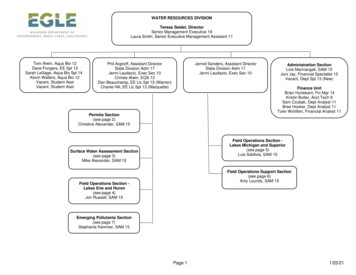Bio-Based Chemicals Overview
Bio-Based Chemicals Overview2019 PCA International ConferenceVancouver, B.C., Canada, 23 - 24 September 2019Doris de GuzmanSenior Consultant – BiomaterialsDoris.de-guzman@orbichem.com
OUR CORE STRENGTHSIntermediates, Fibres & Specialty ResinsSoda AshCaustic SodaEpichlorohydrinEDCVCMEpoxy ResinsPVCAcetoneIsocyanatesChlorinePeroxy POChlorohydrin POBisphenol APolyolsPolyester FilmPolyurethanesPET ResinDerivativesEO DerivativesEthylene OxidePhenolBio-MaterialsMEGPolyester FibrePTAAcetic AcidVinyl AcetateMonomerPolyesterPolypropylene mide 6Adipic AcidAH SaltPolyamide 66Acrylic FibreAcrylonitrilePolyamide FibrePolyamide ResinPolyacetalABS & SANPBTPolycarbonateMethanolMethyl AcrylateEthyl halic r ResinMaleic AnhydrideAcrylic Acid2-Ethylhexyl AcrylateButyl Acrylate2-EHButanolsDOPStyrene2
BIO-MAT E R IAL S& INT E R ME DIAT E SA monthly publication reportingmarket trends, pricing, andfeedstock for Bio-based chemicalsand their PetrochemicalscounterpartS tarted in 2007&Inspired by an unwaveringbelief that we can and will dobetterwww.greenchemicals blog.com3
Value additions of Bio-based Industry to US Economy 364bnForestProducts 22bnBio-basedChemicals 3.5bn(NA) 45bn 106bnEnzymesTextiles 35bn 1.11bnBiorefining 506mSource: USDA, PCAAgricultureandForestryBioplasticbottles andpackaging4
Value additions of Bio-based Industry to E U Economy 47bnWoodProducts,Furniture 56bnBio-basedchemicals,pharma,plastics andrubber 2.5bn 28bn 106bnForestryTextiles 174bnAgriculture 46bnPaperSource: Road-To-Bio Project, PCA 233bnFood,Beverages,Tobacco5
BIOE CONOMY DR IVE R S Chemical/Petrochemical companies aligning themselves with scientificcommunity’s climate change stance Plastic pollution pressures will continue Consumer increase in appetite for ‘naturals,’ ‘holistic,’ ‘sustainablestories’ Synthetic Biology investmentsProduction becoming regional reflecting trade wars and other barriers toentryZero-waste approach and use of waste-based feedstockGrowing government support of circular Bioeconomy EU, Canada, Australia, Thailand China’s drive for environmental regulations6
US PETROCHEMICALS, NATURAL GAS, CRUDE OIL & SUGARPRICES 2014-2019Do lla rs p er m m BtuDo lla rs p er To n 2,0007.006.00Dextrose( / ton)5.00WTI Crude( / ton)4.00Naphtha( / ton)3.00Ethylene*( / ton)2.00Propylene( / ton)1.00Natural Gas( / mmBTU) 1,600 1,200 800 400 02014201520162017Sourc e: Tec non Orb iChem , *Petroc hem wire20182019
EUROPE PETROCHEMICALS, CRUDE OIL & SUGAR PRICES 20142019Do lla rs p er To n 2,000Brent ( / ton) 1,600Naphtha( / ton) 1,200Sugar (ICE)( / ton)Butanes( / ton) 800Ethylene( / ton) 400Propylene( / ton) 0201420152016Sourc e: Tec non Orb iChem201720182019
ASIA PETROCHEMICALS, CRUDE OIL & SUGAR PRICES2014-2019Dolla rs p er Ton 2,000Sugar (ICE)( / ton) 1,600Naphtha( / ton) 1,200Brent ( / ton) 800Ethylene( / ton)Propylene( / ton) 400 020142015Sourc e: Tec non Orb iChem2016201720182019
LOW OIL PRICE DRIVING NEW BIO-REALITIES Companies are refocusing on higher-profit, low-volumespecialty markets Food and Nutrition, Flavors and Fragrances Pharmaceuticals, fine chemicals Higher R&D-based chemicals: lubricants, surfactants,engineering resins, coatings, solvents, high-tech materials(e.g. biomedical) Animal feed and nutrition Novel molecules gaining more interests vs drop-ins Bio-based commodity chemicals will continue as nichemarkets New polymers and applications will have to undergo lengthytesting before they will be accepted
THE BIO-MONOMER REALITIES Success in bio-based monomers: Monomers with competitive pricing or even betterperformance than traditional materials Monomers that offer novel properties Regulation-based demand Improved properties might have short-term priceimplications. Companies introducing bio-based chemicals require: That their operations do not reduce the food supply That a direct replacement (“drop in”) costs the same asits synthetic equivalent -- or maybe slighty more if itallows end users to boast about their environmentaland sustainability initiatives
BIO-POLYUR E T HANE S INT E R ME DIAT E SOil CropsSugarCropsPRESSINGVegetable/industrial oilsEXTRACTIONNatural Oil PolyolsODDA (C18)Sucrose (C12)Polyether PolyolsIsocyanatesSorbitol (C3)1,3 PDOHYDROGENATION1,4 BDOBiomassCarbonDioxideSugarsPRETREATMENT(PILOT)FE R ME NT AT IONSugarsStarchLignocellulose(PILOT)PUFE R ME NT AT IONGlucaric acidREDUCTION(PILOT)SuccinicAcidPolyester PolyolsIsocyanatesAdipic AcidPPC/P E C PolyolsEpoxidesSource: Wageningen UR, Tecnon OrbiChem12
BIO-BASED PU INTERMEDIATES: POLYOLS Maturing vegetable oil-based polyester polyols market Improvements in performance Still possess premiums Biobased Technologies, Cargill, BASF, Dow Chemical, Huntsman,Emery Oleochemicals, Lubrizol, PolyLabs, Vithal Polyols Pvt Polyether polyols based on sorbitol and bio-based diols Isosorbide-based polycarbonate polyol (Mitsubishi Chemical) Isosorbide sourced from Roquette Pentaerythritol polyol (Perstorp’s Voxtar based on bio-acetaldehyde) CO2-based PPC/PEC polyols High potential but long R&D due to specialized formulations Pilot/Demo production Can also be bio-based using renewable-based EO Covestro, Aramco, Jinlong CAS Chemical, Empower, Econic, NornerVerdandi, BASF, Evonik
BIO-BASED PU INTERMEDIATES: DIACIDS/DIOLS Growing interests in alternative bio-based diacids/diols intermediates Can be priced competitive, depending on applications, even if valueaddition in performance involve premiums Diacids Adipic Acid – lower-cost petro-AA prevents bio-AA commercialization Succinic Acid – further application R&D needed Levulinic Acid – few producers, further application R&D needed Glucaric Acid – intermediate for bio-AA production Furandicarboxylic Acid – no commercial production as of yet Long-chain Diacids – commercial DDDA, C18 OCDA Dimer Acids – well-established market w/ some industry restructuring Diols 1,3 Propanediol – sugar-based or glycerol-based 1,4 Butanediol – Novamont production, Genomatica technology MEG and MPG – few producers; various ongoing pilot projects 1,3 Butylene Glycol – currently targets cosmetics applications
L E VUL INIC ACID AS A BUIL DING BLOCK15
BIO-BASED PU INTERMEDIATES: ISOCYANATES Limited developments in drop-in bio-based isocyanates Hexamethylene diisocyanate Drop-in sugar-based HMDA by Genomatica HMDA via fructose-based 1,6 hexanediol Pentamethylene diisocyanate Based on 1,5 PDA produced by Cathay Industrial Biotech BASF, Mitsui Chemicals, Covestro in PU applications Aniline – production of intermediate using sugar and microorganism Covestro leading R&D Target large industrial scale by mid-2020s Malonic Acid – could replace adipic acid or succinic acid Cross-linker that could replace/diminish reliance on isocyanates Lygos, DMC Bio, Sirrus, BASF Development of non-isocyanate PU based on vegetable oils Diisocyanates from succinic anhydride and isosorbide/isomannide
VAL UE-CHAIN OF BIO-BAS E D E POXY R E S INSCo-Reactants- Bisphenol A- Bisphenol F- Other sOtherCo-ReactantsCuringAgentsSource: AGC Chemicals Europe17
BIO-BAS E D E POXIE S & INT E R ME DIAT E S E pichlorohydrin – commercialized glycerol-based ECH Same price as propylene-based ECH P henolic/Cyclic alternatives - mostly still at R&D stages Novolac phenolic resins can be made from bio-basedformaldehyde and phenolic lignin High-phenolic lignins as alternative to benzene-based phenol Formaldehyde using bio-based methanol feedstock 5-HMF in formaldehyde replacement Soy-based reactive oligomer technology can replace BPA Lignin-based bisguiaicol F to replace BPA Rosin diglycidyl ether FDCA-based diglycidyl ester Diglycidyl ethers of isosorbide18
BIO-BAS E D E POXIE S & INT E R ME DIAT E S Co-reactants for aliphatic reactive diluents C12-14 diglycidyl ether using C12-14 fatty alcohol co-reactant 1,4 BDO diglycidyl ether using bio-based 1,4 BDO co-reactant Cardanol glycidyl ether using cashew nut shell liquid (CNSL) Curing agents Bio-based phenalkamines using CNSL C36 fatty acid polyamides using dimerized TOFA CO2-based ammonia as co-reactant for amines Bio-bas ed s olvents us ed in epoxies Aromatics – direct production, bio-naphtha Ketones – acetone from fermentation or bio-benzene; MIBK from bioacetone Ethylene Glycol Ethers –n-butanol or ethanol bio-EO19
OT HE R NOT E WOR T HY BIO-BAS E D BUIL DING BLOCKS T erpenes Growing use of fermentation technologies and synthetic biology Unlimited production using sugar and microorganism Applications in adhesives, fragrances, pest control, cosmetics,etc. L actides – development of lactide-based adhesives Acrylics /Acrylates Bio-based acrylic acid – stalled R&D due to low petro price Bio-based MMA Slow but growing R&D. No commercial production Lucite using building blocks (bio-acetone, bio-ethylene, bio-methanol, etc.) or a novelone-step fermentation route (undisclosed) Itaconic acid route; Isobutene/Isobutanol route; Isobutyric acid route Evonik markets partially bio-based VISIOMER Terra methacrylate monomersincorporating feedstock such as camphene and natural oils20
NEW FE E DS TOCK FOCUS :BIO-NAPHT HA, BIOGAS , BIO-ME T HANOL , CO2 Renewable diesel producers looking to diversify downstream Production of bio-naphtha, bio-propane High investment requirements Naphtha from CTO production - UPM Naphtha/Methanol from MSW feedstock (syngas to syncrude) Continued activities in mass balance approach Use of bio-naphtha, bio-methanol, biogas BASF, SABIC, Dow, DuPont, Perstorp, Neste Bio-oil from pyrolytic plastic wastes Increase R&D/commercialization of CO2 -based chemicals Renewable hydrogen requirements for CCUs21
NEW FE E DS TOCK FOCUS : L IGNIN Pulp and Paper companies lead R&D UPM, Stora Enso, Borregaard, Domtar, West Fraser, Metsa FibreOy Around 55m tpa lignin produced as side product. 1m tonsreaches chemicals market Lignin burned for power and heat Lignin from Cellulosic Ethanol ProductionLignin bio-compositesVanillin from LigninLignin-based aromatics Phenol BTX Bio-oils22
NEW FE E DS TOCK FOCUS :CE L L ULOS IC S UGAR S AND NON-FOOD L IPIDS Sugars from waste agriculture crops Corncobs/stalks, Sugar Bagasse, Wood Chips No commercial markets Low traditional sugar prices Industrial crops R&D Castor, Camelina, Guayule Years of field crop testing Algae R&D Difficulty in commercialization; low yield; high expenses Focus on fuels Waste fats and cooking oils Becoming more expensive compared to plant food oils23
www.orbichem.comDoris.de-guzman@ orbichem.com24
Bio-based acrylic acid -stalled R&D due to low petro price Bio-based MMA Slow but growing R&D. No commercial production Lucite using building blocks (bio-acetone, bio-ethylene, bio-methanol, etc.) or a novel one-step fermentation route (undisclosed) Itaconic acid route; Isobutene/Isobutanol route; Isobutyric acid route
nova-Institute –10 – www.bio-based.eu Wood –spruce, pine and birch into cellulose fibres and bio- based chemicals and polymers Algae such as Kelp into fish feed, bio-based chemicals & polymers and more Chitin from shrimps and crabs into bio-based chemicals and polymers Fish waste via insects into fish feed (proteins) and protein-based .
Dawn Roush, Env Mgr 14 Kevin Goodwin, Aqua Bio Spl 13 Bill Keiper, Aqua Bio Spl 13 Sam Noffke, Aqua Bio 12 Lee Schoen, Aqua Bio 11 Elizabeth Stieber, Aqua Bio 11 Kelly Turek, Aqua Bio 12 Chris Vandenberg, EQA 11 Jeff Varricchione, Aqua Bio 12 Matt Wesener, Aqua Bio 11 Marcy Knoll Wilmes, Aqua Bio Spl 13
159386 BIO BIO 301 Biotechnology and Society 158405 BIO BIO 202 Microbiology and Immunology 158396 BIO BIO 304 Ecology of Place 159428 BIO BIO 300 Population, Resources and Environment 159430 BIO ENS 110 Populations, Resources and Environment 151999 ENG ENG 340 Global British Literature
on bio-based chemicals and materials Vision & Policy Bio-based Building Blocks Bio-based Polymers Biodegradable Solutions Biorefineries NEW Bio-based Fine Chemicals (Food Ingredients, Flavours, Body Care, Cosmetics, Pharmaceuticals) Innovation Award „Bio-based Material of the Year 2019“ www.fkur.com www.neste.com
The production of bio-based chemicals is not new, nor is it an historic artefact (1). Current global bio-based chemical and polymer production is estimated to be around 90 million tonnes (1). Notable examples of bio-based chemicals include fermentation products such as ethanol, lysine and citric acid, and sorbitol, glycerol as well as fatty acids.
Bio-based products Platform & fine chemicals Pharmaceuticals Surfactants Lubricants Polymers Fibres Composites Pulp & paper Wood-based materials Bioenergy Biofuels All services of the nova-Institute You may find all information on conferences and have access to our bio-based news, along with papers on bio-based policy, studies on LCA and Meta .
AlphaGuard BIO The AlphaGuard BIO System is a liquid-applied, bio-based, two-component, polyurethane roof restoration system. The development of AlphaGuard BIO is derived from unique bio-based, polyurethane technology. The high bio-content makes for a sustainable, environmentally responsible roofing product while
Animal Fun Challenge Pack . Fold the paper plate in half. 2. Trace the elephant's outline on one side. 3. Colour or paint the elephant (not the tusk). 4. Cut out the elephant making sure not to cut the folded edge except for the shaping at each end. 5. Carefully cut out the paper plate section between the legs leaving the edge of the paper plate connecting the legs to make the rocker. (This .























